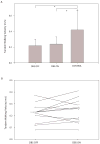Gait and balance in essential tremor: variable effects of bilateral thalamic stimulation
- PMID: 19006189
- PMCID: PMC2882155
- DOI: 10.1002/mds.22356
Gait and balance in essential tremor: variable effects of bilateral thalamic stimulation
Abstract
Essential tremor (ET) is a multi-faceted condition best known for postural and action tremor but also may include disordered gait and postural instability. Deep brain stimulation (DBS) of the ventral intermediate nucleus (VIM) of the thalamus provides substantial tremor reduction yet some patients with bilateral VIM DBS have gait and balance impairment. This study examines gait and balance performance in 13 participants with ET who have bilateral VIM DBS compared with a matched control group. Participants with ET were tested with their stimulators off (DBS OFF) and on (DBS ON). For both standard and tandem walking, participants with ET walked significantly more slowly than controls, with significantly lower cadence, spending a lower percentage of the gait cycle in single limb support and a higher percentage in double support compared with controls. Participants with ET also had significantly lower tandem and one leg stance times, Berg balance scores, balance confidence, and required significantly greater time to perform the Timed Up-and-Go relative to controls. There were no significant differences in any gait or balance measures in the DBS OFF versus DBS ON conditions, but the effects of DBS on gait and balance were highly variable among individuals. Future studies are needed to determine why some individuals experience gait and balance difficulties after bilateral thalamic DBS and others do not. A better understanding of the mechanisms underlying gait and balance impairments in those with bilateral DBS is critical to reduce falls and fractures in this group.
(c) 2008 Movement Disorder Society.
Figures



References
-
- Benito-Leon J, Louis ED. Essential tremor: emerging views of a common disorder. Nat Clin Pract Neurol. 2006;2:666–678. - PubMed
-
- Singer C, Sanchez-Ramos J, Weiner WJ. Gait abnormality in essential tremor. Mov Disord. 1994;9:193–6. - PubMed
-
- Deuschl G, Wenzelburger R, Loffler K, Raethjen J, Stolze H. Essential tremor and cerebellar dysfunction clinical and kinematic analysis of intention tremor. Brain. 2000;123:1568–80. - PubMed
-
- Stolze H, Petersen G, Raethjen J, Wenzelburger R, Deuschl G. The gait disorder of advanced essential tremor. Brain - PubMed
-
- Parisi SL, Heroux ME, Culham EG, Norman E. Functional mobility and postural control in essential tremor. Arch Phys Med Rehabil. 2006;87:1357–64. - PubMed
Publication types
MeSH terms
Grants and funding
LinkOut - more resources
Full Text Sources
Medical
Miscellaneous

